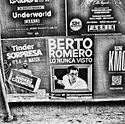Carnie Bob
Member
I agree with Lachian and Koraks here, I would like to see practical examples from a worker making prints today.
I have seen some DT prints and they were lovely, but I do not know of anyone doing current work with the process.
I think the visual proof is important.. I make tri colour GB over Palladiums that can match monitor.. so when I want to get into a
discussion with someone about this process I would like to see their expertise level visually , not ripping text out of manuals and regurgitating.
I was interested in this thread because I do make daily colour separation negatives via PS to inkjet negs , and was quite intrigued to talk with someone currently making sep negs as well.
I have seen some DT prints and they were lovely, but I do not know of anyone doing current work with the process.
I think the visual proof is important.. I make tri colour GB over Palladiums that can match monitor.. so when I want to get into a
discussion with someone about this process I would like to see their expertise level visually , not ripping text out of manuals and regurgitating.
I was interested in this thread because I do make daily colour separation negatives via PS to inkjet negs , and was quite intrigued to talk with someone currently making sep negs as well.












